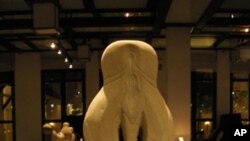Though the temples of Angkor Wat have some amazing stone carvings, contemporary sculpture in the country has not been widespread.
But a group of 14 young Cambodian sculptors wants to change that. They currently have 26 pieces of modern stone sculptures on display at a new exhibition hall at the Royal University of Fine Arts in Phnom Penh.
The sculptures, whose meanings can be hard to decipher if not for the display tags, are the result of more than a year of hard work for the artists.
Sasha Constable, the curator of the first exhibition of its kind in the country, said the show is aimed at encouraging more young Cambodian contemporary artists and the Cambodian public to better support this kind of art.
“There is not really a market for contemporary Cambodian art within the Cambodian community,” she said in an interview at the opening session of the exhibition on Thursday night. “I really hope that will change soon, because it’s a shame really that the elder are not supporting the younger generations of artists when there is so much talent here.”
The sculptures depict animals, like fish, and forms of the human body, such as the clasped hands of a woman in front of a headless torso.
Ouk Chimvichet’s work includes “Wonder,” the carving of a male face with earrings and long hair curled into a question mark.
“The meaning of the sculpture is to have transsexual individuals consider thoroughly whether they should get their sex organs and identity changed,” the 30-year-old sculptor told VOA Khmer.
Chhea Bunna, another sculpture graduate from the Royal University of Fine Arts, brought seven of his pieces to the show. He said his efforts were to move Cambodian sculpture toward the international trend in modern art.
“When I was at school, I was taught only how to make traditional sculptures, so I want to leave these artworks of mine for the younger generations,” he said. “If we do not make something new and the next generations have to learn the old ones, we cannot move forward. The art of other countries is updated, so I want our art to go forward as well.”
Khmer traditional stone sculptures are internationally acclaimed for their detail and beauty, as shown on the walls of thousands of ancient temples across the country, especially at Angkor Wat, a national icon.
So Chenda, dean of the Royal University of Fine Arts, said the young sculptors’ work taught them about the efforts of their ancestors in building the famous temples and also showcased Cambodian ideas and imagination.
“These young sculptors are full of innovative ideas,” he said in an interview. “And they not only preserve our traditional artwork, but they also help develop our art as well.”
The exhibition is supported by Friends of Khmer Culture, a public charity registered in the US. Visitors can purchase individual pieces, and a percentage of the sales will be used for equipment and material for the university. The exhibit runs through June 6, after which it will move to the Hotel de la Paix in Siem Reap, through Aug. 8.
Culture Minister Him Chhem said Cambodia needs such artwork to help push local art onto the international stage.
“We want to see our artists and their work recognized overseas,” he said.
Taket Meta, an university student who was attentively examining a stone sculpture, said this kind of art made him think and try to read the mind of its creator.
“If the sculptures showed us clearly what they were about, we would just have a look and then walk away,” he said in an interview at the exhibition. “But with these abstract pieces, we have to spend time and think about what they want to tell us.”




